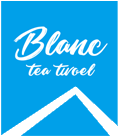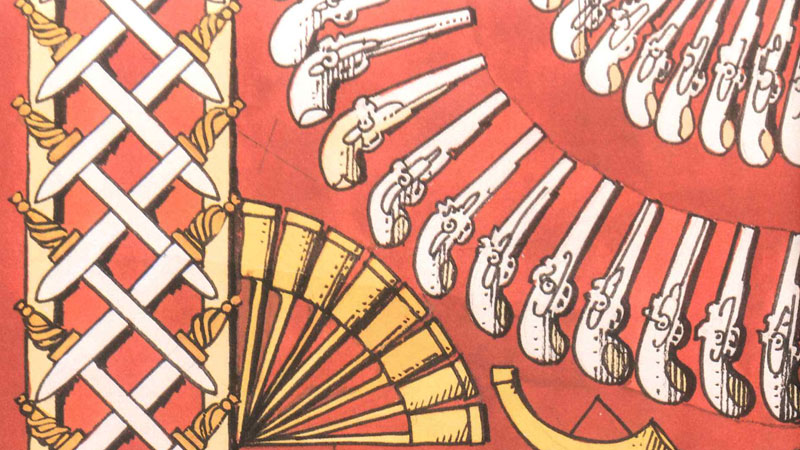Although mistress of the narrative and descriptive tea towel, Pat was first and foremost a textile designer and it was in the sphere of pure pattern that she was at her very best. Pat’s early career was devoted to fashion and subsequently furnishing fabrics working first for Horrockses and later for Cavendish Textiles, the print division of the John Lewis partnership. Pat saw the opportunities presented by putting into repeat those motifs that seemed to characterize a National Trust property: for Culzean Castle strong colored backgrounds set off rattling cutlasses. Passions for samplers, patchwork, or cut paper similarly found their way into the collection. In the case of the Standen pattern, an homage to her beloved hero William Morris (whose designs fill the house), the tea towel quickly led to a comprehensive collection of household items in tin, textiles and ceramics.
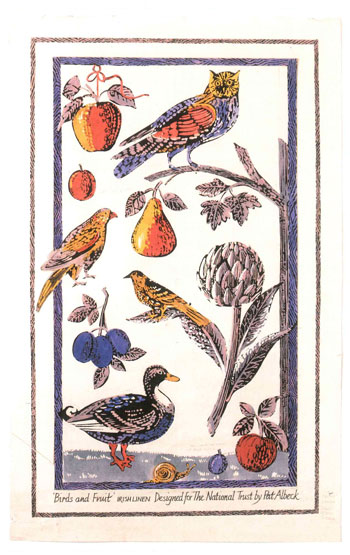
Sometimes Pat experimented with new techniques. She was most excited by this woodcut/linocut approach and it certainly uses the printing limitations to remarkable and new effect.
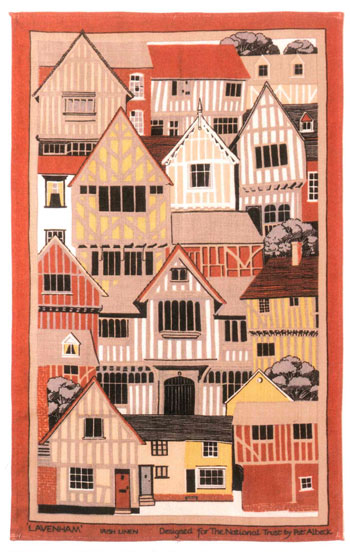
The bleached timber studding and colour-washed infill of Lavenham’s medieval houses are of great interest to lovers of old buildings but for Pat they became an arrangement of vertical stripes and triangles. She was pleased to note that they were reminiscent of her parents’ half-timbered 1950s villa in Hull.
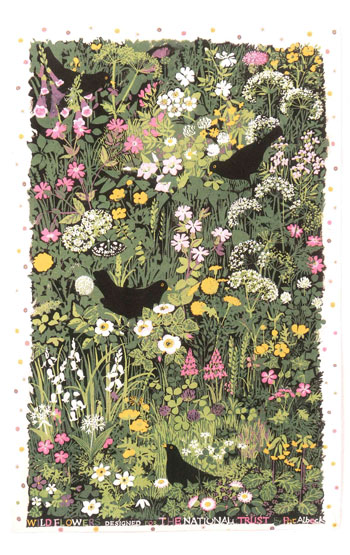
Pat’s ornithological interests were severely limited-although fond of chickens and more so of white ducks-blackbirds were really the only wild bird she claimed an interest in (actually she also liked song thrushes…), perhaps
because with their untroubled black outfits and smart yellow beaks they were a strong contrast with a flowery background, as this design shows so well. The jewel-like tapestry of wild flowers was a trope to which she repeatedly returned.
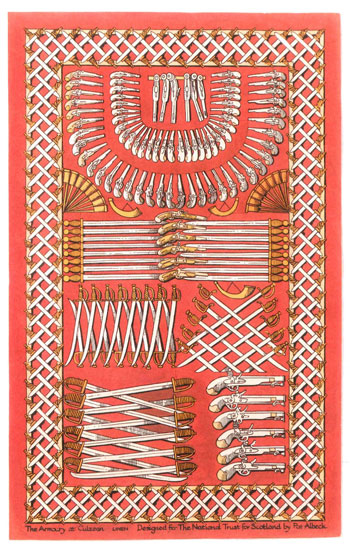
Arms and armour were never of particular interest to Pat, for whom the domestic sphere was always in the ascendancy. But the patterns into which these were arranged at Culzean Castle in Ayrshire definitely did attract her attention.
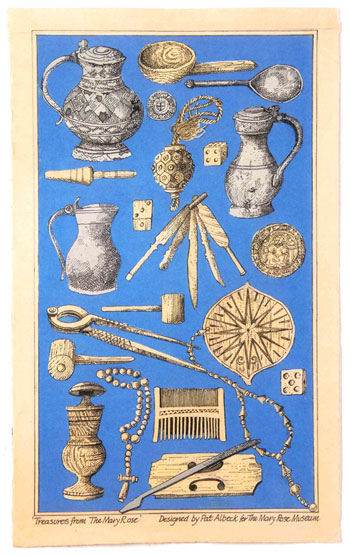
As late as 2015 Pat much enjoyed her visit to the restored wreck of the Mary Rose, unusually for her in a wheelchair kindly pushed around the museum by its chairman Admiral John Lippiett. ‘Very good looking’ she commented, before producing this splendid design based on the treasures rescued when the ship was raised from the sea floor 20 years earlier. At 85 she was still at the height of her powers.
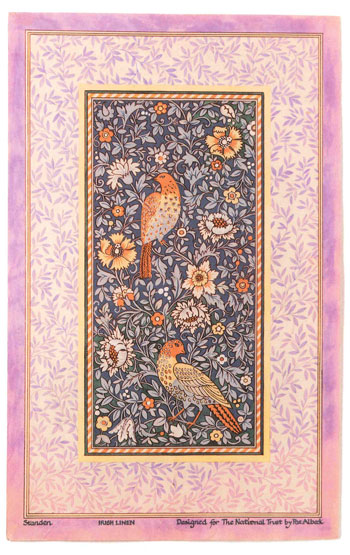
William Morris, designer, entrepreneur and socialist, was Pat’s particular hero. The bearded giant of the Victorian decorative arts was much admired by Pats adored father and this design was in the spirit of a humble acolyte (not a frequently assumed persona for Pat, who was an utterly confident designer). Morris, while a sophisticated and sinuous twister and manipulator of the natural world was also a faithful portraitist of his floral models, capturing their particular form and growth even in the most highly wrought design. Pat was channelling Morris’ popular print ‘Strawberry Thief’ when she was producing ‘Standen’,but somehow the line and colour and eventually the whole design becomes her own.
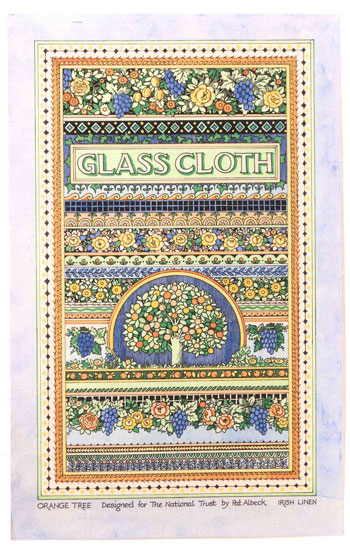
Part-stained glass but perhaps just a straightforwardly decorative design of the sort that came very directly from Pat’s designers mind: flat colour, repeating borders of a basically floral theme, a controlled palette of bright, non-primary colours and a clear message.
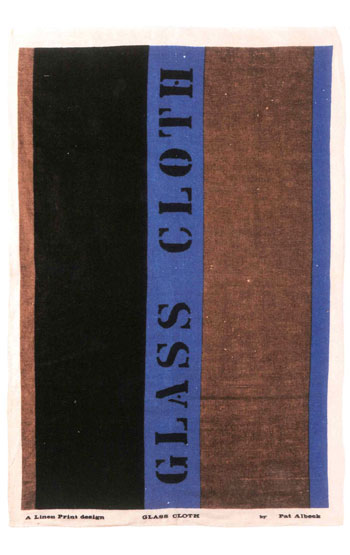
This uncharacteristically spare design, printed linen in imitation of a woven cloth, is a design from the 1950s produced for Cavendish Textiles. It was a great favourite, and Pat felt it needed no more embellishment.
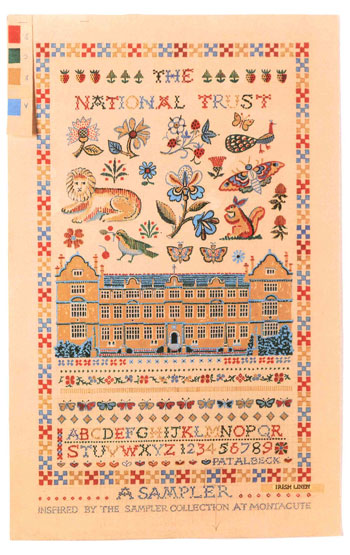
The endless boredom of a Victorian childhood had some dividends and the long afternoons of ennui gave rise to
the sampler, a demonstration of a young girl’s virtuoso skill with needle and embroidery thread. Familiar symbols – house, flower, leaf or crown – decorated an alphabet or thoughtful motto, all on a cream linen ground, such as the example seen here inspired by the sampler collection at Montacute. They appealed to Pat, who revisited them several times – once as the theme for one of over 40 National Trust calendar tea towels that she produced (the first in 1976, the last for 2019).
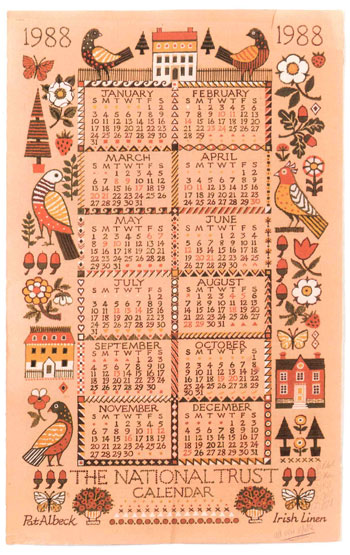
Another sampler, this time used to find a new way of representing a property The isolated elements are also inspired by sixteenth- and seventeenth-century stumpwork embroidery.
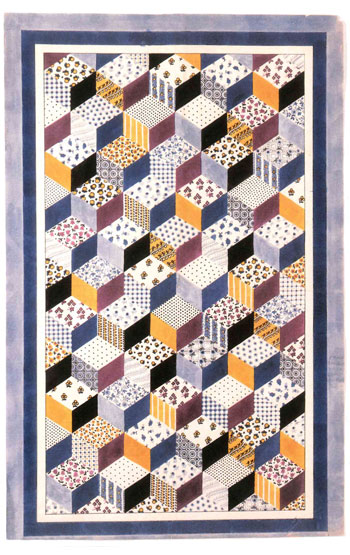
Pat never made a patchwork although she was for a time an inspired designer and executor of petit point embroidery… but the tumbling dice motif seen here was one that gave her great pleasure.
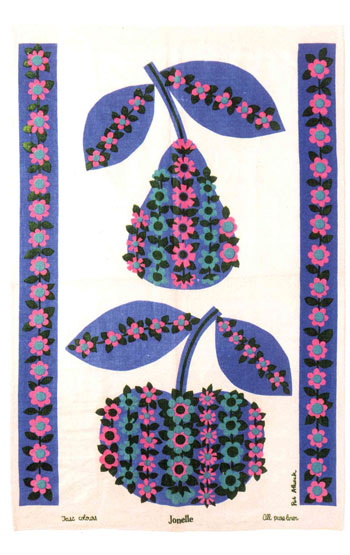
Pat produced this series of cloths for Jonelle, part of the John Lewis Partnership, in the 1950s. They were in uncompromisingly bold colours and the stark arrangement of symbols on a plain white ground is striking. She carried out these designs in cut paper and tissue paper, a style to which she was to return half a century later.
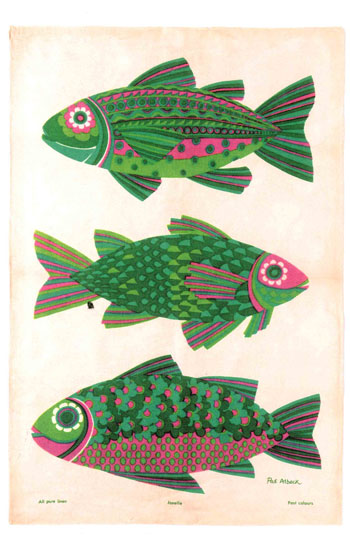
These three almost bilious green fish are quite fat, as were most of Pats animals. While the designs are formalised 一 almost iconographic 一 they are still clearly fish with the correct number and disposition of fins.
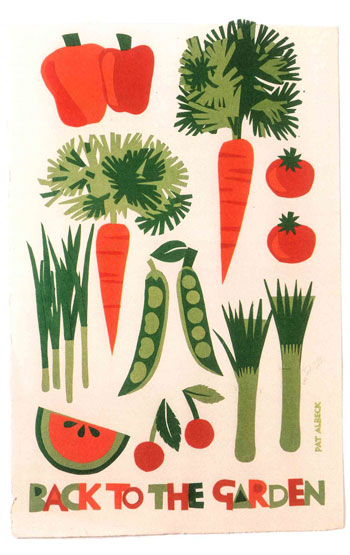
design for a particularly stylish organic farm shop in Norfolk belonging to her friend the actor and landowner Delaval Astley. They were both members of a poetry group, and she very much loved his voice and delivery: Cut paper again…
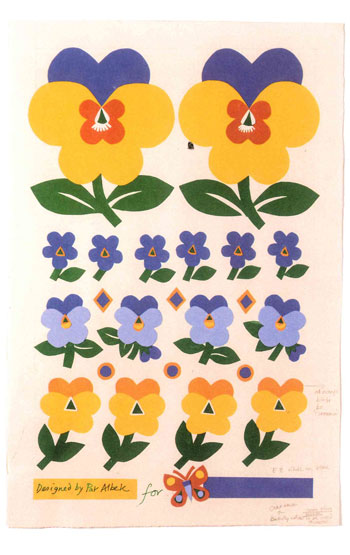
Pat would buy pansies with minimum provocation. A large earthenware pot of them was often found beside her front door, despite her husband Peters 65-year, much-voiced resistance to their charms. She was much taken with the seemingly endless variations that breeders could evolve into and the simple, face-like geometry of their smiling flowers.
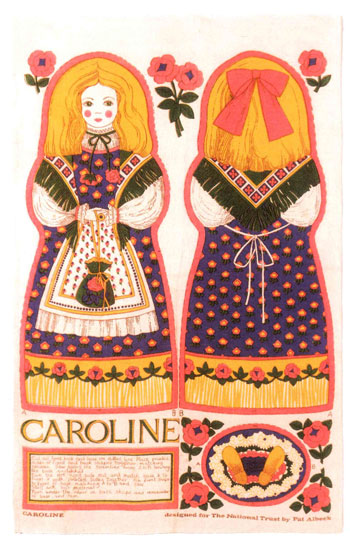
Caroline was one of several doll tea towels designed to be cut out and sewn into real dolls. The ensuing doll or girl was rather long and thin but otherwise she would have looked huge when flat.
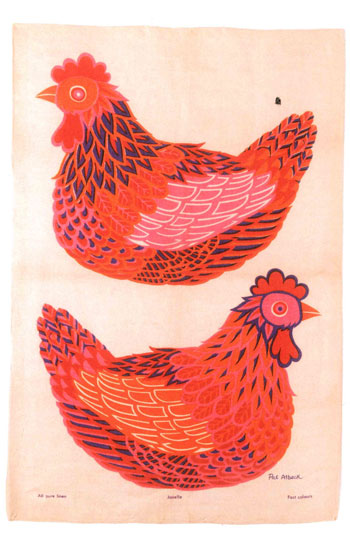
Chickens were often used as inspiration and a small flock lived in the back of Pats London garden in the days before the feral foxes that appeared in the garden made this seem impossible. The lacing of their feathers (where one coloured feather is lined with another) appealed to her desire for pattern in all things.
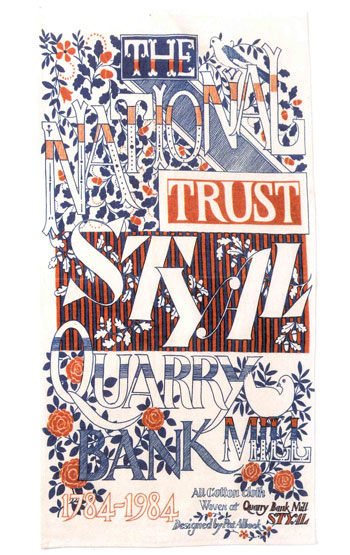
Pat’s pleasure in manipulating lettering is attested to by its frequent use in her designs. This second design for Quarry Bank Mill is just such a cloth (incidentally printed on cotton not linen as this was what was actually woven in that rural Cheshire factory). With the writing in strong diagonals and in varying decorated and open face fonts, the pattern has something of the nineteenth-century trade advertisement about it The National Trust acorn, seen through the prism of Victorian prints is woven amongst the lettering and the design is printed in two screens only adding to its engraved quality.
